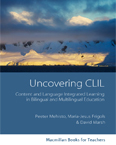Gilberto Terente reviews Uncovering CLIL, commenting on how it helps us to look at the past, present and future challenges of CLIL. He concludes that 'a new CLIL teacher after reading this book is ready to be a good CLIL teacher!'
 |
Summary
Authors: Peeter Mehisto, David Marsh, and María Jesús Frigols
Publisher: Macmillan Education, 2007
Reviewer: Gilberto Terente, Foreign languages adviser at Oviedo´s teachers centre, Asturias, Spain.
Summary: The book has eight chapters. We learn how to use CLIL at primary, secondary and vocational levels.
Target audience: CLIL teachers
Classroom scenario: CLIL students at primary, secondary and vocational levels.
Personally, I really enjoyed reading this book and I'd like to highlight the following ideas I got from reading it.
Past: Background to CLIL
We get a general overview about CLIL throughout history and we learn that CLIL was used 5000 years ago by the Akkadians who conquered the Sumerians and they wanted to learn their language.
We also learn that Latin was used to teach content for centuries, but CLIL is different from the Latin model because CLIL seeks to support second language learning while also favouring first language development.
Bilingual education seemed a privilege to the wealthy but it isn't so nowadays with CLIL taught at all kinds of schools, state and private, and aimed at all kind of students, not only clever students. In my autonomous community, The Principality of Asturias, in Spain, CLIL is taught in 130 primary, secondary and vocational schools.
The processes for selecting and admitting students mentioned in the book are quite useful: first come, first served, lottery and testing.
In Asturias, when we have more demand than posts available we have a lottery, at state schools we never take into account the student marks to join a CLIL programme.
Present: How things are nowadays and how this book can help CLIL teachers
After reading Uncovering CLIL one has the impression to be ready to teach CLIL because we're told why and how to teach CLIL.
We have many activities for all levels and they can be adapted to other languages. We also get useful tips and views from the field. Ideas are also given to use the mother tongue in CLIL. Many subjects are covered such as Biology, Maths, Chemistry, ICT, vocational studies. All throughout the book we have many examples of tables and mind maps that can be adapted to most CLIL lessons
The CLIL triad is also mentioned, that's to say, how to integrate:
- Content
- Language
- Learning skills
Following the new education law in Spain all teachers have to put an emphasis on learning skills and we can get many ideas from the book. All activities in the book are student-centred and we have useful classroom management tips.
Most benefits from CLIL are mentioned:
- Students learn a foreign language quicker because they use it
- Co-constructing meaning with students is a key characteristic of CLIL
- Fostering critical thinking
- It develops successful life-long learning in the interconnected global society
- It helps raising awareness of how we learn
- It helps teachers to work together
- Students develop metalinguistic awareness
- By developing joint projects, or by building a unit around a cross curricular common theme, learning has a wider application
Other areas also covered in the book:
- The importance of school links is highlighted and we're told ways to link schools through different programmes and projects. All schools in Asturias that have joined a CLIL programme have school links abroad.
- Ideas for well balanced lessons: warm-up, teaching/learning, reflection
- Ideas to start projects and theme projects
- Assessment is also included in different parts of the book.
What I miss in the this book
- There should be more references to:
- The Common European framework and to the Council of Europe languages portfolio
- More ideas to develop learning skills
- How to attend diverse learner needs
- How to work with a language assistant
- All activities should have a similar structure and include at the end reflection and self assessment following EPL, and develop successful life-long learning in the interconnected global society
- More sources of information should be given
- It's not clear enough how to evaluate CLIL students
Challenges for the future
A new CLIL teacher after reading this book is ready to be a good CLIL teacher! Teaching through another language brings with it special challenges. Each teacher will always bring to the CLIL classroom his or her own experience and style, so CLIL always remains a flexible approach.
Conclusion
One of the advantages of CLIL is its immediacy, that's to say, students use immediately what they learn; so, with Uncovering CLIL, written by experienced educators, a teacher has immediate materials ready to start and new ideas for the CLIL classroom.
September 2009

No comments yet